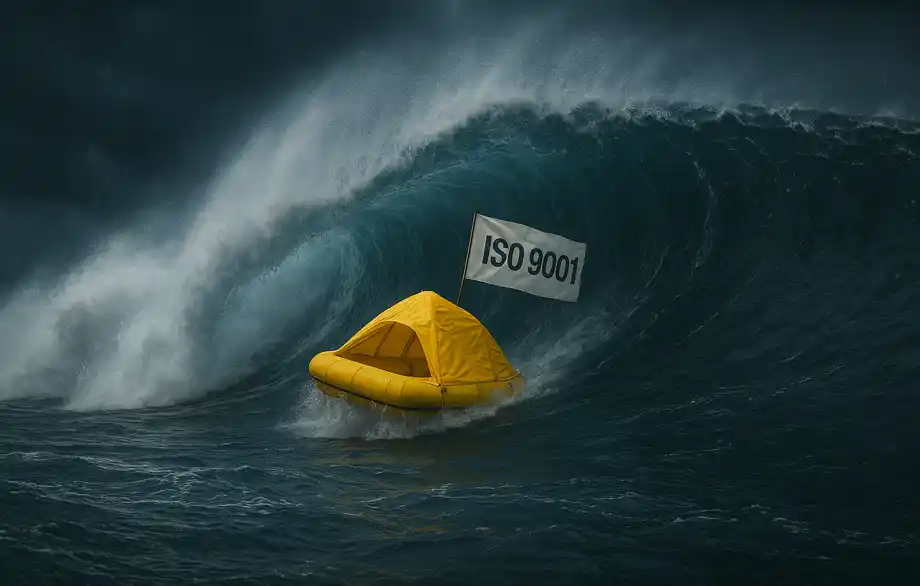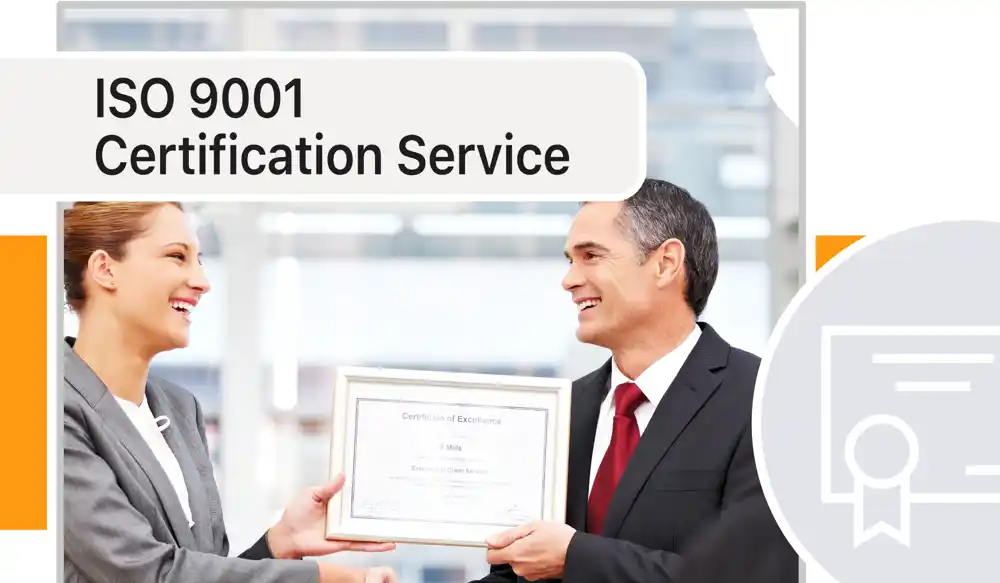How to Use ISO 9001 to Mitigate Tariff Risks During Trade Wars
14 April 2025
As global trade tensions escalate with new tariffs reaching up to 145% on critical imports, businesses face unprecedented pressure to adapt. Rising costs, customs delays, and supplier disruptions threaten profitability, forcing companies to seek resilient solutions.
Enter ISO 9001, the internationally recognized Quality Management System (QMS). While traditionally associated with quality control, ISO 9001's structured approach to risk management, process optimization, and supplier oversight makes it an unexpected but powerful tool for navigating tariffs and trade wars.

How to Use ISO 9001 to Mitigate Tariff Risks The Tariff Crisis: Challenges for Businesses
Escalating Costs Squeeze Profit Margins
The 2025 tariffs have already led to 20–30% cost increases for manufacturers relying on imported materials. The automotive sector has been particularly hard hit, where tariffs on steel and aluminum have added approximately $2,000 to the production cost of each vehicle.
Supply Chain Disruptions Cause Delays
Tariffs don't just increase costs – they disrupt logistics. Nearly half of manufacturers now experience regular shipment delays due to customs bottlenecks. A Texas robotics startup, for example, lost 8 weeks of production waiting for tariff-cleared parts.
Compliance Complexity Leads to Penalties
The complexity of modern trade regulations has led to a sharp increase in compliance violations. Customs agencies now issue penalties exceeding 10% of shipment values for documentation errors, creating substantial financial risks for unprepared businesses.
ISO 9001 isn't just about quality – it's a survival toolkit for trade wars. Companies using it holistically turn a cost center into a competitive edge.
Greg Thompson / 9001Simplified
How to Use ISO 9001 to Mitigate Tariff Risks ISO 9001 Framework: A Strategic Approach to Tariff Mitigation
ISO 9001's true power lies in its systematic integration of requirements that drive ongoing adaptation. Beyond isolated clauses, the standard's interconnected clauses build a holistic tariff-resilience strategy. Below examples illustrate how ISO 9001 clauses contribute to comprehensive tariff risk mitigation in practice:
Strategic Risk Management
ISO 9001's requirements for Context of the Organization (Clause 4) and Risk-Based Thinking (Clause 6.1) work in tandem to create a proactive tariff mitigation system. Clause 4 compels businesses to map internal and external factors such as tariff policies, supplier locations, and customer tolerance for price increases, and conduct a SWOT analysis. These insights directly feed Clause 6.1's action framework, where companies evaluate supply chain vulnerabilities using probability-impact matrices, then implement tiered responses and contingency plans.
For example, when new tariffs hit a medical device manufacturer's Chinese-sourced components, their ISO 9001 processes enabled rapid, data-driven decisions: shifting 8 of 12 affected parts to Vietnam (using pre-vetted suppliers from their risk register), while redesigning 2 others to avoid tariffs completely. This wasn't crisis management – it was their quality system functioning as designed, proving ISO 9001's risk framework anticipates disruptions before they become emergencies.
Smart Redesign and Process Optimization
Building on Clause 4's customer insights and Clause 6.1's risk analysis, ISO 9001's operational clauses transform tariff threats into opportunities for innovation and efficiency. Clause 8.3's structured controls enable strategic design modifications to qualify for lower tariffs by altering materials, components, or assembly processes. These redesigns work in concert with Clause 8.5's production controls, where lean methodologies systematically eliminate waste.
For example, when Clause 4 revealed customers would accept certain design changes over price hikes, and Clause 6.1 flagged high-risk materials, one calibration equipment manufacturer used Clause 8.3 to redesign sensor housings using tariff-exempt polymers and modify assembly sequences to qualify for preferential HTS codes. These changes fed directly into Clause 8.5's production controls, where they implemented lean workflows that reduced material waste by 18%. As a result, the company outperformed competitors in terms of margins while simultaneously increasing its market share.
Supply Chain Resilience
Clause 8.4 operationalizes earlier risk insights (Clauses 4/6.1) and process optimizations (Clauses 8.3/8.5) by transforming supplier relationships into tariff shields. When redesigns (8.3) reduce dependency on high-tariff components or lean workflows (8.5) lower material needs, Clause 8.4 ensures suppliers align with these strategic shifts through diversified sourcing to match redesigned specifications, FTZ partnerships to defer/reduce duties, and contract renegotiations to share redesign costs or relocate value-add steps.
For example, a Michigan auto supplier, after using Clause 4 to flag Chinese parts included in an imported transmission component and Clause 8.3 to redesign the component, leveraged Clause 8.4 to audit/onboard Mexican suppliers in 60 days, renegotiate contracts to shift final machining across borders, and implement joint lean training reducing material waste and increasing productivity. This shows that, with ISO 9001, supplier management isn't just procurement, but the culmination of interconnected systems.
The Documentation Backbone
Clause 7.5 ensures every critical process, from supplier agreements to customs declarations, is anchored in accurate, accessible, and controlled documentation. By controlling documentation systems and standardizing templates for customs clearance, businesses eliminate errors that trigger penalties or delays. Automated workflows further embed compliance into daily operations – ensuring updated trade regulations are instantly reflected in customs forms, while version control prevents outdated classifications. Controlled record-keeping and retention systems directly reduce tariff risks by creating audit-proof documentation chains and lead to customs savings through first sale pricing validation.
For example, an industrial valve manufacturer demonstrated this when facing 15% tariffs on Chinese components. By implementing Clause 7.5's document controls, they automated HTS classifications (cutting errors by 90%), centralized first-sale evidence, and reduced customs clearance times from 4 weeks to 3 days. Their impeccable documentation not only avoided penalties but became a key differentiator in winning aerospace contracts requiring full supply chain transparency – proving rigorous documentation delivers both protection and profit.
Continual Improvement
ISO 9001's true differentiator lies in its self-reinforcing system for tariff adaptation. The interconnected clauses create a foundation, but it's the standard's process approach and Plan-Do-Check-Act (PDCA) cycle, internal audits, and management reviews that institutionalize responsiveness. These processes ensure tariff strategies evolve through risk reassessments, supplier performance analyses, and compliance workflow audits – turning geopolitical shifts from crises into managed variables.
How to Use ISO 9001 to Mitigate Tariff Risks Actionable Steps to Apply ISO 9001 for Tariff Resilience
1. Implement Document Controls (Clause 7.5):
Apply controls to ensure that all documents, including tariff classifications and regulations, are current, correct, and readily available to users, minimizing costly errors.
Automate documentation and classification processes to ensure HTS (Harmonized Tariff Schedule) codes, descriptions, and customs forms are consistently error-free.
Implement a comprehensive record keeping and retention system allowing easy access to important documents, including transaction records, allowing you to determine if "First Sale" import pricing (i.e., the price paid in the first sale) could be applied to reduce your tariff burden.
2. Analyze Your Organizational Context (Clauses 4.1 & 4.2):
Identify tariff-vulnerable components, suppliers, and processes.
Analyze current customer preferences to identify opportunities to save costs by altering product characteristics.
Utilize the methods offered by Clauses 4.1 and 4.2 to find new, international markets, enabling you to apply for duty reimbursements upon export.
3. Consider Your Options to Address Risks and Opportunities (Clause 6.1):
Implement organization-wide risk-based thinking enabling each department to continuously identify and mitigate process-specific risks.
Engage in a systematic approach to determine and address all important risks and opportunities, particularly in the context of tariff changes and supply chain disruptions, and develop contingency plans.
4. Redesign Products (Clause 8.3):
Use Clause 8.3's design controls to establish alternative product designs, components and assembly methods that reduce reliance on components affected by high tariffs.
Apply design validation process to test tariff-friendly materials or assembly methods.
5. Optimize Production (Clause 8.5):
Institutionalize the ISO 9001's process approach to increase efficiencies, cut waste and offset increased costs.
Leverage the controlled process change methods to ensure smooth implementation.
6. Strengthen Supply Chains (Clause 8.4):
Develop partnerships with vendors in favorable trade zones (low-tariff regions or FTZs) and diversify sourcing.
Re-route import and export shipments to Free Trade Zones (FTZ) or favorable regions where products could be altered, assembled or dissembled to meet lower tariff classification.
Utilize bonded warehouses to stage supplies till their actual use in order to delay the actual import.
7. Train Teams (Clause 7.2):
Educate appropriate staff on how to access the latest HTS classifications, and how to comply with tariff regulations.
Teach teams the use of established contingency plans to enable quick reaction to tariff changes.
Conclusion
While tariffs present significant challenges, ISO 9001 provides a proven framework for mitigating tariff risks. Companies that leverage these strategies not only survive trade disruptions but often emerge stronger, with more efficient operations and resilient supply chains.
Ready to take the next step?
>> Get a custom proposal for our ISO 9001 Certification Service today
>> Schedule a consultation with one of our experts
There is no risk in trying 9001Simplified – our solutions come with an industry-leading 30-Day Money-Back Guarantee and free QMS updates.


